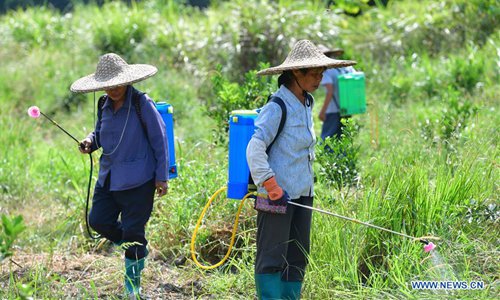HOME >> CHINA
Netizens question E.China province's poverty data
By Leng Shumei Source:Global Times Published: 2020/1/8 15:33:26
Targeted system helps poor, contributes to China’s 2020 plan: expert

Photo: Xinhua
Chinese netizens are questioning poverty relief data from the government of East China's Jiangsu Province, which announced on Tuesday that only six families containing 17 people are still living in poverty in the province after four years of its poverty alleviation campaign.Over the past four years, 2.54 million people have been lifted out of poverty in Jiangsu, which has a population of 80.5 million, bringing the local poverty relief rate up to 99.99 percent, The Beijing News reported Tuesday, citing the provincial government.
The 17 people still living in poverty are capable of working, and four of them have diseases, an official from the Jiangsu provincial poverty relief office told The Beijing News on Wednesday, without releasing further details.
The data, which is based on national and provincial data bases, shows the number of poor people as of December 31, 2019, the anonymous official said.
"The data may change in one week. Some people will get rid of poverty, while others will fall back," the official said, noting that the fluctuations will be minor.
China's national poverty-relief line is 4,000 yuan ($576) per person per year. Jiangsu completed the criteria in 2015, the official noted.
The current standard of poverty relief in Jiangsu is a resident who earns 6,000 yuan ($576) a year, according to Xue Feng, a senior government official from Dongtai county in northern Jiangsu.
The data trended on Chinese social media platforms, with netizens discussing its accuracy. Hashtags related to the topic have been viewed more than 90 million times on China's Twitter-like Sina Weibo.
"How could they be so accurate?" was a typical comment.
"I don't believe it. Are there no unemployed people in the province? No beggars?" a Weibo user asked.
Zhuang Deshui, a deputy director of the Research Center for Government Integrity-Building at Peking University, said the data indicates that China's poverty alleviation work has become more and more targeted and detailed.
"The authorities are clear of the scale of poverty and the number of people living in poverty," Zhuang said.
As China plans to rid all of its residents of extreme poverty by 2020, Zhuang said a detailed and targeted working system will contribute to achieving the goal and reduce poverty according to each family's and each person's specific situation.
A detailed mechanism has also helped prevent corruption as local officials in some places used to report false numbers of poor people to extort money from the central government, analysts said.
In a campaign in 2017 jointly launched by the State Council and the Ministry of Finance, authorities recovered 730 million yuan in poverty alleviation falsely claimed or embezzled.
Other netizens criticized skeptics, saying they show little knowledge of and respect for the country's decades of poverty relief work.
"I'm a Jiangsu resident. I believe the news and feel bitterly disappointed seeing these comments. There were reports of the sudden deaths of poverty relief workers due to overwork. Their work is really tiresome and difficult. We should thank them," a Weibo user named xianggejiahao said.
Some noted such data is convincing in Jiangsu, which has the country's second largest GDP, only behind South China's Guangdong Province.
Jiangsu's provincial GDP in the first three quarters in 2019 reached 7.22 trillion yuan, an increase of 6.4 percent compared with the same period in 2018.
"In our county the level is 6,500 yuan and is easy to reach," Xue told the Global Times on Wednesday.
Per capita disposable income of Dongtai residents was 31,817 yuan in 2018, showing a year-on-year increase of 8.9 percent, according to the county government's website.
Meanwhile, per capita disposable income in Jiangsu was 38,096 yuan in 2018, with urban dwellers having 47,200 yuan and rural residents 20,845 yuan, the Economic Daily reported.
The anonymous poverty alleviation official said that they pursued a blood-making method to motivate the 17 people to get rid of poverty through work, rather than just giving them handouts.
Xue said poverty alleviation workers will create files for each poor family and record the family's conditions in detail, including their land, income and subsidies.
Local workers will help poor residents acquire skills and find jobs. For people who lose the capacity to work, like senior citizens and those with disabilities, local governments will give them money to make sure they do not live in poverty, Xue said.
Newspaper headline: Netizens question province's poverty data
Posted in: SOCIETY